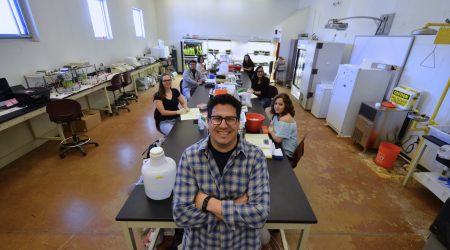Researchers are working to decipher how one immune-boosting compound, QS-21, is produced by the Chilean Soapbark tree
Humans have used plants for thousands of years to help treat disease and improve health, and the global pandemic highlights the value of these treatments.
The Chilean Soapbark tree (Quillaja saponaria) is one such plant.
Fondly known in Chile as the quillay tree, the name alludes to some of its historical and continued uses. The word ‘quillay’ is derived from the native Mapuche word ‘quillean’ meaning ‘to wash’. The Latin name again refers to its cleaning potential with ‘sapo’ meaning soap.
Historically bark from the tree has been used as detergent, and later as a food additive and in beauty products.
The useful, soapy compounds in the bark of the quillay tree belong to a group of complex specialised chemicals called saponins. Many plants produce saponins and it is believed their role inside plants is to defend against diseases.
Saponins have a role not just in plant health, but in human health too. Claimed benefits include cholesterol reduction, antioxidant activity and cancer risk reduction.
In 1925 it was first shown that the addition of saponin in early treatments to prime the immune system, enhanced antibody responses to diseases such as diphtheria and tetanus. It was later found that one saponin from the Chilean Soapbark tree was most effective in producing a suitable immune boosting effect – named QS-21.
QS-21 is an adjuvant, a word which describes molecules that boost the immune response of a vaccine. The addition of an adjuvant to a vaccine stimulates the human body to produce more antibodies, reducing the amount of vaccine needed and potentially increasing the efficacy of the vaccine.
Despite advances in the field of adjuvants, only a few have been licensed for human use. QS-21 is one. The first vaccine containing QS-21 was approved in 2017. This means that demand is high and is expected to increase as vaccines are developed in response to the coronavirus pandemic.
However the extraction process from the Chilean Soapbark tree poses its challenges. Extracts from the tree must be purified – a difficult process with variable results.
Researchers at the John Innes Centre are studying how QS-21 is made in plants, with the hope that this could lead to an alternative way to make this medicinal molecule.
Professor Anne Osbourn’s group have expertise in discovering how plants produce terpene molecules, a group to which saponins belong.
Professor Osbourn explains, “We previously unravelled how an antifungal saponin in oat is made, by discovering that the genes of this production pathway are found next to one another in what is termed an operon-like gene cluster”. This discovery led to group to turn to the QS-21 saponin.
Dr Laetitia Martin joined the team and is working to decipher this plant production puzzle. The research poses a number of genetic, chemical and practical challenges.
As Dr Martin explains, “Working on a non-model species always brings a set of difficulties. Finding the genes responsible for making a specialised metabolite can be similar to looking for a needle in a haystack. As Quillaja saponaria is not widely studied, in part because of its narrow natural growing range, publicly available resources are limited. This endeavour is also challenging as the QS-21 molecule contains several unusual sugars and a long acyl chain with no correspondence in the known set of plant saponins.”
The soapy qualities of saponins complicate studies further.
“Their ability to attract water and lipid substances, which gives them properties such as foaming, disrupt the way chemicals usually behave in a standard protocol,” explains Dr Martin. “For example, phase separation between aqueous and organic solvents, which is used in a lot of purification protocols, does not occur because of the saponins contained in the extract.”
Despite the obstacles in the search for how plants produce QS-21, the team are optimistic.
Recent genomic advances have allowed the team to sequence the genome allowing them to mine for metabolomic gene clusters that could be involved in producing saponins. They are now using knowledge from across plant science to detect enzymes that could be involved in the QS-21 production pathway.
Understanding how QS-21 is made by the Chilean Soapbark tree offers the potential to understand how other useful saponins are produce in plants and beyond.
Continuing, “Better knowledge of these genes would also allow further investigation of the roles of saponins in plants as they often remain speculative. Some marine animals such as seaslugs and starfish also produce saponins.”
Technology previously developed at the John Innes Centre offers the next step in an alternative production of QS-21.
Hypertrans, developed by the Lomonosoff group is a plant-based system for producing molecules in easily purifiable and high quantities. It uses the fast-growing tobacco plant, Nicotiana benthamiana.
The Osbourn group have optimised this system for expression of biosynthetic pathways and production of chemicals in easily purifiable and high quantities. They are currently using this platform to test candidate enzymes, but it could also be used beyond discovery research of the QS-21 pathway to scale up production.
QS-21 would still be produced by plants but in an easier and quicker way. This work highlights the importance of fundamental plant science in helping face global challenges such as the coronavirus pandemic.
Dr Martin reflects, “It is already rewarding to work on a class of molecules that can have such positive effect on people, but it is particularly thrilling to work on a project that can have a massive impact on society through vaccine development. This work is especially relevant in the Covid-19 era as the Novavax vaccine contains Quillaja saponaria saponins in its Matrix-M™ adjuvant. Working on the QS-21 project is therefore incredibly exciting and rewarding as it marries biological investigation of understanding a specialised metabolite pathway to its usage for a greater good.”






